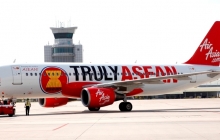AirAsia was launched in 2001 with the dream of making flying possible for everyone. Since then, AirAsia has swiftly risen to become the world’s best...
-

Air Travel
Where to invest?
Air Travel
The move towards an ASEAN Single Aviation Market boosted infrastructure investment and aviation development plans in the region. Growth is also attributed to the proliferation of low-cost carriers. Demand for flights rose with the expansion of the middle income class, driving regional competition and positively impacting the industry of aviation.
Passenger growth
Analysts anticipate that almost half of the world’s air traffic growth will be driven by travel to, from, and within the Asia-Pacific region during the next 20 years. According to ACI's estimates, the Southeast Asian market peak is expected to soar between 2023-2042, including the Philippines, India, Indonesia, and Thailand, with a CAGR of 6.2%-7.2%. More importantly, Baronci highlights that there is significant untapped potential in these top three markets. Among these countries, Indonesia has extraordinary potential, where only 0.32% of its 277 million population currently utilize air services.1
At Routes Asia 2024 in Langkawi, Malaysia, Stefano Baronci, Director General of ACI Asia-Pacific and Middle East, delivered a promising forecast for Indonesia. He projected that Indonesia will rank as the seventh busiest passenger market in the world by 2032, and will soar even higher to the fourth position by 2042. This prediction reflects the extraordinary potential of Indonesia's aviation industry, presenting a golden opportunity for Garuda Indonesia to transform into a global aviation giant.2
Aircraft demand
Held in Bangkok, at the 66th President's Assembly of the Association of Asia Pacific Airlines (AAPA) conference, Boeing [NYSE:BA] launched the 2022 Commercial Market Outlook (CMO) for Southeast Asia. This report brings good news for the aviation industry in the region, predicting a return to rapid growth over the next 20 years. This is accompanied by a forecasted need for over 4,200 new commercial aircraft to meet this surge in demand. The company projects that the current fleet of commercial aircraft in Southeast Asia, which numbers 1,600 aircraft, will increase, with the predicted market value of this fleet growth being US$ 245 billion.3
The data shows that the largest demand is focused on single-aisle jets, with an estimated 3,430 units. This reflects the rapid growth of low-cost airlines in Southeast Asia serving short and medium-haul flights.
Wide-body aircraft are also predicted to experience an increase in demand, with a need for 740 units. This indicates a rising demand for long-haul flights and intercontinental connectivity.
Additionally, 50 regional jets and 35 cargo aircraft are also predicted to be needed to meet various aviation needs in this region.4
Airport developments
Countries in Southeast Asia are racing to expand and enhance their major airports to cope with the surge in domestic demand and attract foreign investment and tourists. This is done in hopes of boosting economic growth and reviving the tourism sector impacted by the pandemic. Nikkei research indicates that the total annual passenger handling capacity at the major airports of the seven ASEAN countries (Thailand, Vietnam, the Philippines, Malaysia, Indonesia, Singapore, and Cambodia) will reach 653 million people by 2030. This figure is nearly double the capacity of 336 million people in January 2023, indicating a remarkable increase in flight demand in the region.
Thailand has upgraded its new Satellite Terminal at Suvarnabhumi Airport, opened in September 2023, increasing the airport's capacity by 30% to 60 million passengers per year. A new international airport near Phnom Penh, Cambodia, is under construction and scheduled to open in 2025, with a target capacity of 30 million passengers per year by 2030.
Meanwhile, Vietnam is expanding Noi Bai International Airport in Hanoi with an investment of nearly 100 trillion dong ($4 billion), increasing its capacity to 60 million passengers by 2030. Malaysia and Singapore are gearing up to welcome the passenger surge with ambitions to double their airport capacities. Malaysia targets 150 million passengers, twice the current capacity, while Singapore aims for 140 million passengers, a 75% increase from the current number.5
[1]https://aviationweek.com/air-transport/airports-networks/industry-optimistic-southeast-asia-growth
[2]https://aviationweek.com/air-transport/airports-networks/industry-optimistic-southeast-asia-growth
[3]https://boeing.mediaroom.com/news-releases-statements?item=131170#:~:text=Get the Latest from Boeing&text=This represents a huge growth,second largest market in Asia.
-
Air travel has a valuable role in accelerating the Integration of ASEAN economies. As the region pushes for open skies and move towards a single aviation market, dreams of seamless connectivity among the 10 ASEAN countries and its neighbours is definitely within reach.
SUCCESS STORIES
-
- Site Map
- Terms & Abbreviations

